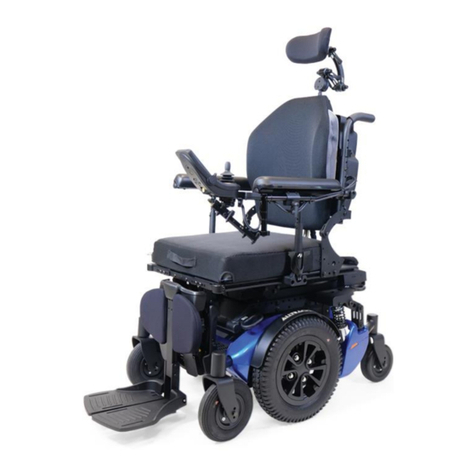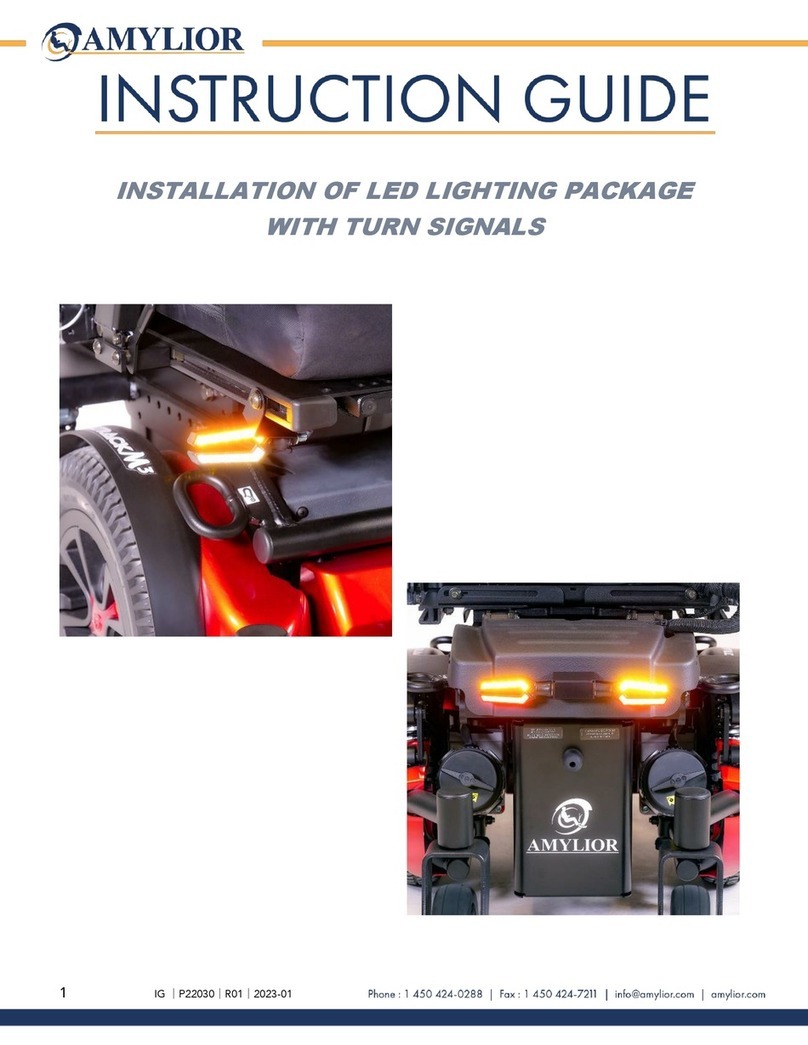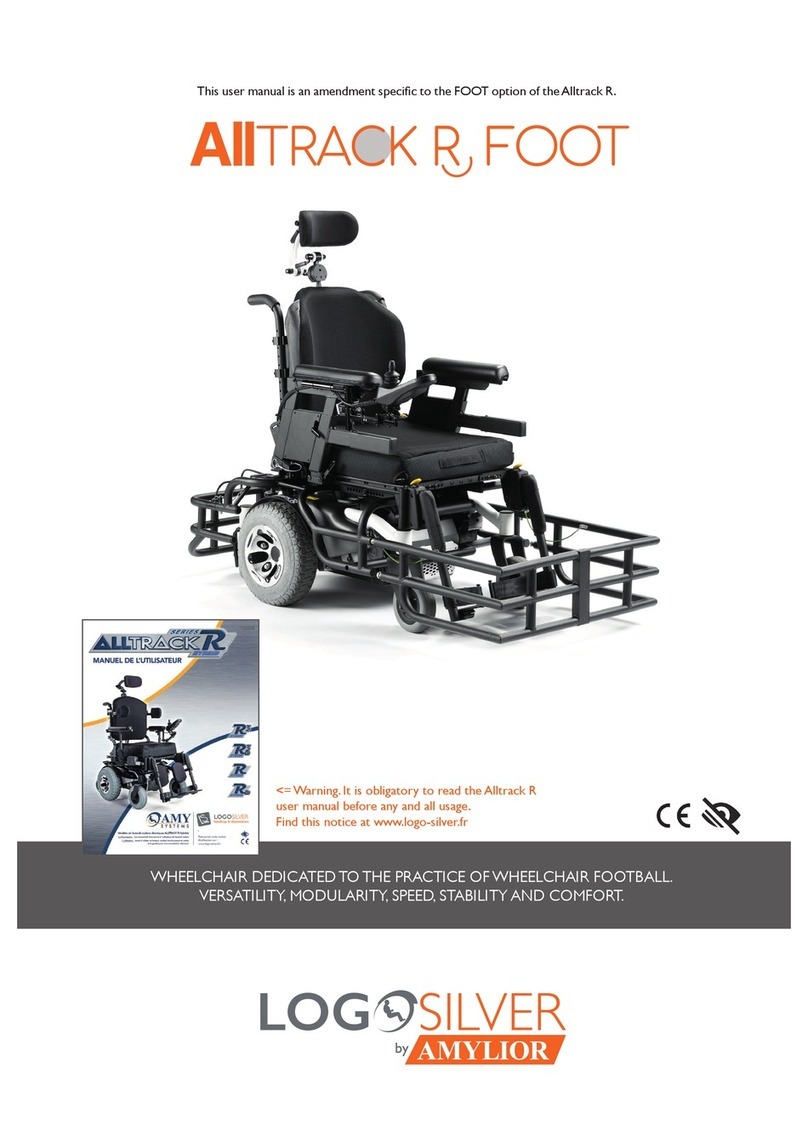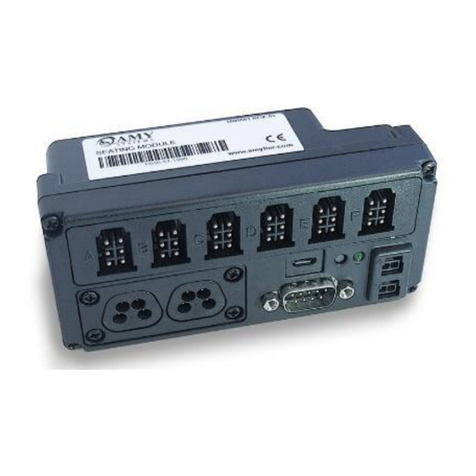
3
Center mount adjustment ...................................................23
Cantilever armrest adjustment...........................................24
Multi-axis headrest.............................................................25
Standing function................................................................26
Pelvic belt............................................................................26
Chest strap ....................................................................26-27
Knee support ................................................................28-29
Joystick ................................................................................30
Freewheel & brake release levers..................................... 31
IX. OPERATING GUIDE 32-42
R-net joystick assembly ...................................................... 32
Locking or unlocking the joystick.......................................32
Display settings for R-net color models ............................32
Performance control settings .............................................33
Thermal roll-back................................................................33
Power seating/standing options.................................34-37
Power options operation through the joystick..................38
Power seating/standing activation.............................38-41
Single power activation.....................................................38
Multiple power activation............................................39-41
Storing power positions in memory ..................................40
Power seating/standing operation pictogram legend.... 41
Troubleshooting guide for power options ........................42
X. BATTERIES 43-44
Introduction.........................................................................43
Battery charger...................................................................43
Charging batteries .............................................................44
Disposing of batteries ........................................................44
XI. MAINTENANCE 44-47
Notes and warnings...........................................................44
Cleaning..............................................................................45
Disinfecting & re-using a power wheelchair....................45
Storage tips.........................................................................45
Battery maintenance..........................................................46
Pneumatic tires................................................................... 46
Maintenance chart.............................................................46
Ordering parts....................................................................47
XII. AMYLIOR LIMITED WARRANTY 47
XIII. PRODUCT SPECIFICATIONS 48-49
APPENDIX A 50
Battery connection label....................................................50
II. TABLE OF CONTENTS
I. INTRODUCTION 2
II. TABLE OF CONTENTS 3
III. YOUR POWER WHEELCHAIR AND ITS PARTS 4 - 5
IV. NOTICE - READ BEFORE USE 6
Recommendations and hindrances for
using the standing function .................................................. 7
V. EMI (ELECTROMAGNETIC INTERFERENCE) 8 - 9
Description, effects and sources of EMI ............................. 8
Immunity level....................................................................... 9
Report all suspected EMI incidents..................................... 9
EMI from power wheelchair................................................ 9
VI. GENERAL WARNINGS 10 - 17
Notice to user and attendants .......................................... 10
Weight limit..........................................................................11
Power module settings ........................................................11
EMI.......................................................................................11
Safety checklist................................................................... 11
Customizations, changes & modifications ........................11
When seated in a parked wheelchair ............................. 12
Environment, terrain and street use ................................... 12
Motor vehicle safety / Transit use .................................... 13
Center of Gravity................................................................ 13
Transfers ............................................................................. 14
Leaning or reaching........................................................... 14
Dressing or changing clothes ............................................ 14
Obstacles............................................................................ 15
Driving in reverse ............................................................... 15
Ramps, slopes & sidehills .................................................. 15
To reduce the risk of falls, tip-over, or loss of control....... 16
Ramps at home/work and lifts.......................................... 16
Curbs, stairs, and escalators.............................................. 17
VII. WARNINGS: COMPONENTS & OPTIONS 18 - 21
Armrests............................................................................... 18
Batteries .............................................................................. 18
Cushion and sling seats ..................................................... 18
Fasteners ............................................................................. 18
Foot platform/footplates ................................................... 18
Freewheel release levers & brake release layers............. 19
On/Off switch.................................................................... 19
Pneumatic tires.................................................................... 19
Positioning belts.................................................................. 19
Push handles....................................................................... 19
Seating systems ..................................................................20
Upholstery fabric................................................................20
Power seating/standing options.......................................20
Weight capacity for power options.................................. 21
VIII. SET-UP, ADJUSTMENT & USE 22-31
Adjustments and tools needed ..........................................22
Battery use ..........................................................................22
Reset breaker......................................................................22
Removing the batteries.......................................................22








































